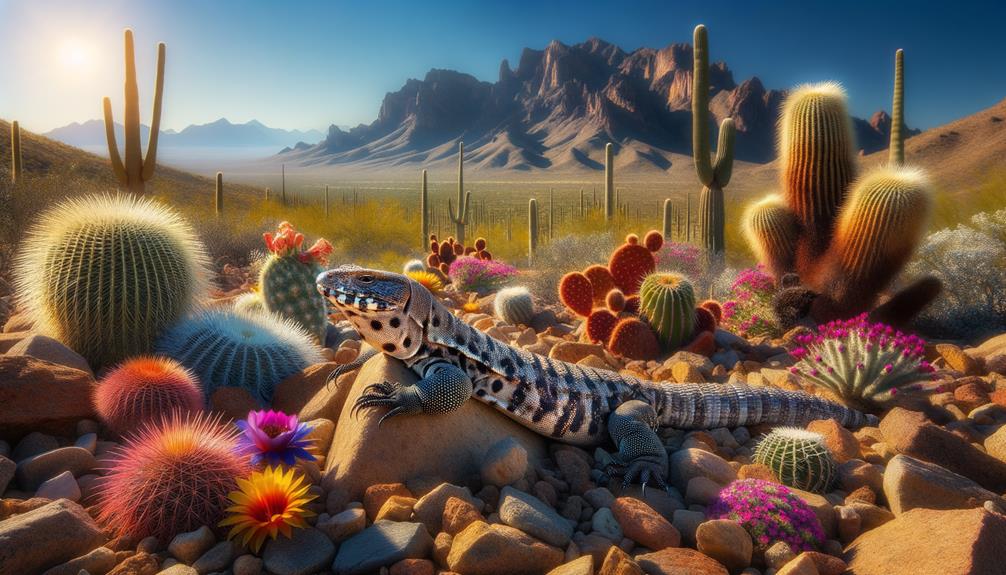Sidewinders in the Mojave Desert are like nature's own desert acrobats, their unique sideways movement a testament to evolution's ingenuity. Their bumpy scales and sand-colored camouflage never fail to impress. These snakes call the arid regions of California, Nevada, Utah, and Arizona home, thriving where many creatures struggle. Their resilience, hunting prowess, and high birth rates make them key players in the desert's delicate balance. But it's their distinctive way of moving that really catches the eye. How does this odd locomotion help them succeed in such a challenging environment? Let's take a closer look.
Physical Characteristics
The Mojave Desert Sidewinder, a small but tough snake, usually grows between 43 and 76 cm long. These reptiles have adapted brilliantly to their harsh, dry home. Their bodies are covered in 21 rows of rough, bumpy scales that help them blend in with the sandy desert floor. Females typically outsize males, giving them an edge in the unforgiving Mojave.
What really sets these snakes apart is how they move. Their unique sidewinding motion lets them glide across loose sand without wasting energy or getting too hot. As they slither, they leave behind J-shaped tracks – a clear sign of their clever evolution.
The scales on their bellies are crucial for survival too. Male sidewinders usually have 141 or fewer, while females can have up to 144. These scales give them traction and protection as they navigate the desert. Their beige and brown coloring is another smart feature, making them nearly invisible against the sandy backdrop.
All these traits work together, allowing the Mojave Desert Sidewinder to thrive in one of the toughest environments on Earth. It's a testament to nature's ability to adapt and overcome challenges, even in the most extreme conditions.
Habitat and Distribution

Sidewinders are right at home in the sandy expanses of the Mojave Desert. Their distinctive sideways movement lets them glide across dunes and flats with surprising ease. You'll find these snakes in places like southeastern California and southern Nevada, where the dry climate and sparse plant life provide perfect cover. This environment suits their hunting style, as they blend in while searching for lizards and small mammals to eat. The sidewinder's adaptation to this harsh landscape is a testament to nature's ingenuity, allowing these reptiles to thrive where many other creatures struggle.
Preferred Living Conditions
Sidewinders thrive in the sandy stretches of the Mojave Desert. They prefer areas with desert washes, flats, and dunes for burrowing and hunting. The sand suits their unique sidewinding movement, helping them move efficiently and escape the blistering ground temperatures. They often pick spots with plenty of shrubs, which offer cover from predators and chances to ambush prey.
You'll spot sidewinders most often in places like San Bernardino, Inyo, and Kern Counties across the Mojave. These areas have lots of wind-blown sand, perfect for their burrowing needs. These snakes are well-suited to warm climates, being most active from mid-spring to early fall. During the hottest summer days, they slow down to avoid extreme heat.
Their success in such tough conditions shows how adaptable and tough they are. Whether they're moving through woodlands, shrubby areas, or bare landscapes, sidewinders have mastered desert living. This makes them a fascinating subject for anyone interested in nature's resilience.
Geographic Range
Sidewinders have managed to carve out a niche in some of North America's harshest desert landscapes. These remarkable snakes call the sandy habitats of southeastern California, southern Nevada, southwestern Utah, and western Arizona home. Their range even stretches into Mexico's desert regions. They thrive in areas dominated by sandy flats, dunes, and creosote brush, where warm temperatures prevail.
You'll find sidewinders across the Colorado and Mojave deserts, as well as the southern Great Basin. They're most common in desert washes and sandy flats. From mid-spring to early fall, these snakes are active in these arid environments, though they limit their movements during the hottest summer months to save energy and water.
These adaptable creatures do well in various desert settings, including woodlands, shrub areas, barren zones, and dunes. They often take shelter in mammal burrows or under objects on the ground, both for hunting and protection.
Let's break down their geographic range:
| Region | Habitat Type | Key Features |
|---|---|---|
| Southeastern CA | Sandy flats, dunes | Warm temperatures, creosote brush |
| Southern Nevada | Desert washes | Sandy habitats, arid climate |
| Southwestern Utah | Shrub areas, dunes | Creosote brush, sandy flats |
| Western Arizona | Barren zones, dunes | Desert washes, creosote brush |
| Mexico | Various desert types | Warm, sandy habitats |
The sidewinder's ability to thrive in such challenging environments speaks volumes about their toughness and adaptability.
Locomotion and Behavior
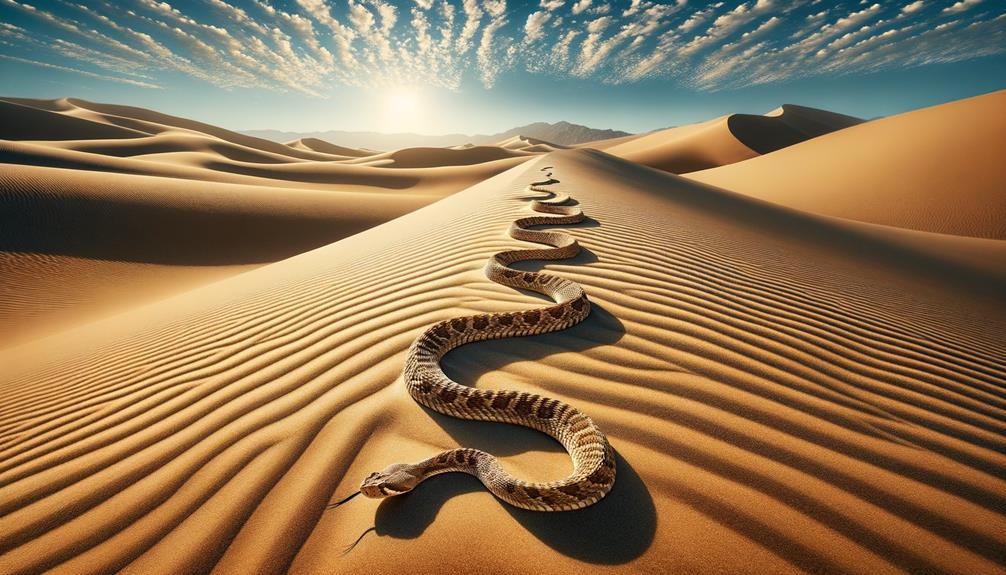
Sidewinders in the Mojave Desert show off their unique way of moving across the sand. They don't slither straight ahead like most snakes. Instead, they move sideways in a series of loops. This clever trick helps them save energy and keeps them from sinking into the soft sand.
Watch a sidewinder and you'll see its body form S-shapes as it moves. Only two parts of its body touch the ground at once. This smart design lets the snake glide over the sand without getting stuck. It's not just cool to watch – it's how these snakes survive in the tough desert.
The sidewinder's movement isn't its only trick for desert life. These snakes come out at night when it's cooler. They're experts at blending in with the sand and can move quickly when they need to. All these skills make them well-suited to life in the Mojave.
Their special way of moving helps sidewinders in many ways. They can hunt for food, escape from danger, and travel across their sandy home without wearing themselves out. It's a perfect example of how animals adapt to live in challenging places.
Diet and Predation
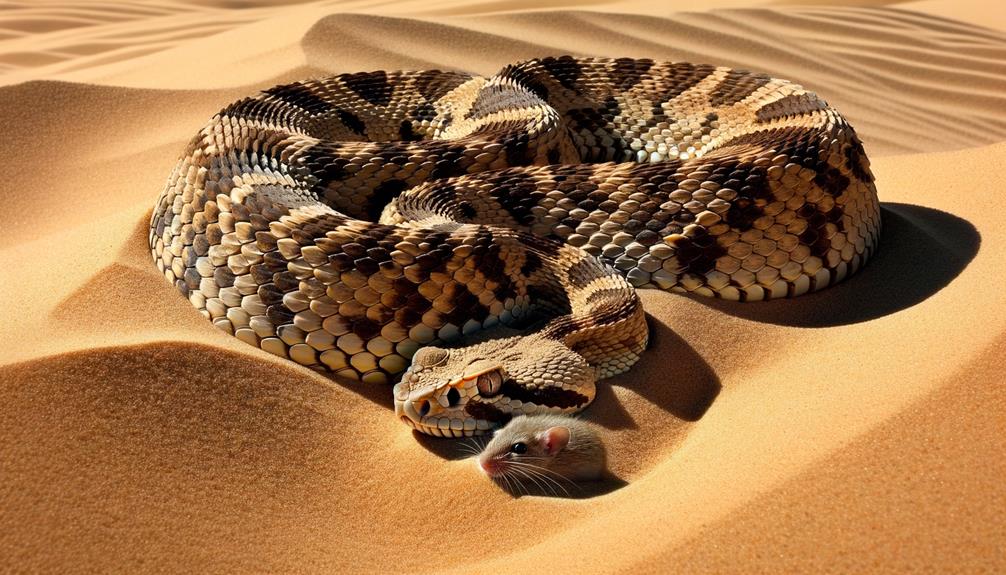
Sidewinders are impressive hunters in the Mojave Desert, mainly eating lizards, pocket mice, and kangaroo rats. They also snack on small birds and other snakes when the opportunity arises. These snakes use a mix of active searching and waiting in ambush, showing how well they've adapted to their environment. They often hide under bushes or partly bury themselves in sand, waiting for prey to come close.
Thanks to special heat-sensing organs, sidewinders can spot warm-blooded animals even in the dark, making them very effective predators. This ability is crucial in the tough desert environment, where staying alive depends on being stealthy and precise. It's interesting to see how their unique side-to-side movement lets them move quickly and quietly, saving energy while hunting.
But sidewinders aren't at the top of the food chain. They have to watch out for kingsnakes, roadrunners, and other desert animals that might eat them. Even so, sidewinders play a big part in keeping the desert ecosystem balanced by controlling the numbers of small mammals and reptiles. Their presence shows just how complex and interconnected life is in the Mojave Desert.
Reproduction and Lifespan
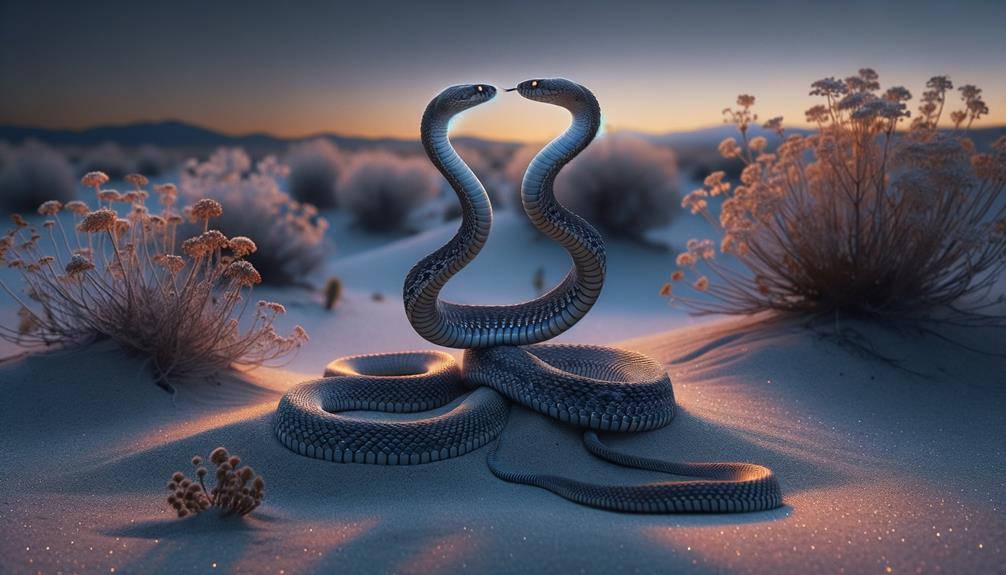
Sidewinders showcase intriguing mating rituals each spring, typically in April and May after they emerge from hibernation. Female snakes reach sexual maturity around their third year. They give birth to live offspring in mid-summer, usually producing about 11 young per litter. Although these snakes generally live only about five years, they ensure species survival through annual reproduction cycles. This consistent breeding pattern helps maintain sidewinder populations despite their relatively short lifespans.
Mating and Courtship Behaviors
Sidewinders' mating rituals and reproduction are key to their survival in the Mojave Desert's tough conditions. These snakes get busy in spring, typically April and May, with some fall action too. Male sidewinders pull out all the stops to woo females, showing off with intricate moves and touches that work well in their sandy home turf.
Unlike many scaly critters that lay eggs, female sidewinders give birth to live young. This direct approach to reproduction significantly impacts how their population grows and thrives. A single litter can have up to 18 baby snakes, though most moms stick to around 10. This high birth rate is crucial for keeping their numbers up in such a harsh environment.
Female sidewinders usually start having babies when they're 2-3 years old and can do so yearly, which helps the species bounce back from tough times. Their larger size compared to males might give them an edge in both having babies and staying alive. Getting the lowdown on these snakes' love lives and baby-making strategies helps us grasp how they manage to thrive in the unforgiving Mojave sands.
Lifespan in Wild
Sidewinders' mating habits offer a window into their wild existence. These snakes typically survive about 5 years in nature. Females become able to reproduce between ages 2 and 3, kicking off their breeding cycle. Most mate in April and May, though some pair up in autumn, following a yearly pattern.
A typical litter includes around 10 babies, with some mothers producing up to 18. This reproductive rate keeps their numbers steady, reflected in their 'least concern' status on conservation lists.
Female sidewinders generally live about 5 years in the wild, while males tend to have shorter lives. Factors like predators and harsh environments likely contribute to this difference. The snakes' ability to have multiple offspring each year helps maintain their population despite these challenges.
These details about sidewinders' lives are key. They show how these reptiles balance growing, breeding, and surviving in the tough Mojave Desert, highlighting their impressive ability to adapt and endure.
Venom and Safety
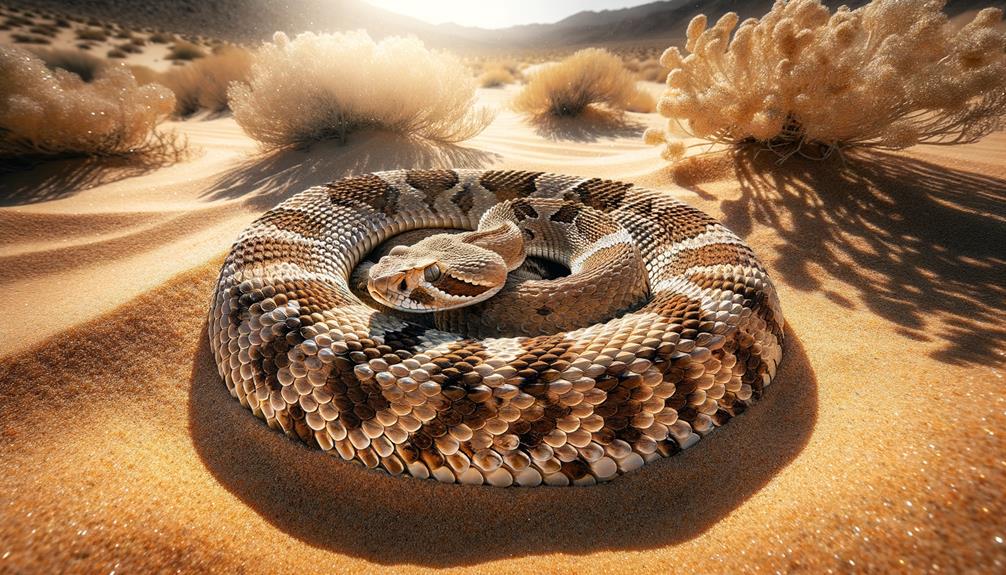
Sidewinder bites pack a serious punch. The venom can cause intense pain, swelling, and potentially fatal reactions, making quick access to treatment crucial. These North American pit vipers produce a complex mix of toxins in their venom glands. Bite victims might experience bleeding under the skin, bruising, nausea, dizziness, chills, blood clotting issues, and shock. The severity of these symptoms highlights why getting medical help fast is so important.
Doctors typically use CroFab antivenom to treat sidewinder bites. Giving this medication quickly can significantly reduce the toxic effects and improve recovery. The key is spotting the symptoms early and starting treatment right away. It's always best to talk to a local expert or poison control center about the right dose and proper care.
Knowing the risks of sidewinder bites helps us appreciate why medical help is so vital. While the desert offers a sense of freedom, it's wise to be aware of its hidden dangers. Understanding venom and safety can make the difference between life and death in an encounter with these snakes.
Frequently Asked Questions
Do Sidewinders Live in the Mojave Desert?
Sidewinders call the Mojave Desert home. These snakes feel right at home in the warm, sandy landscape, using their distinctive side-to-side movement to get around. At night, they come out to hunt, targeting lizards and small mammals for their meals. The Mojave's harsh conditions suit these adaptable reptiles perfectly, allowing them to thrive where other species might struggle.
How Venomous Are Sidewinders?
My research on sidewinders shows they pack a serious punch. Their bites can cause intense pain and swelling, making them a real threat. While their venom isn't as potent as some other rattlesnakes, it's still dangerous. Quick treatment with CroFab antivenom is crucial for anyone bitten. Don't underestimate these snakes – they're not to be trifled with.
Do Sidewinders Bury Themselves in Sand?
Sidewinders do indeed bury themselves in sand. As someone who's watched these snakes up close, I can tell you it's a key part of how they survive. They partly sink into the sand to control their body heat, hide from animals that might eat them, and surprise the small creatures they hunt. It's amazing to see how well they've adapted to life in the desert.
Does the Mojave Desert Have Snakes?
Snakes are indeed part of the Mojave Desert's wildlife. I've come across various species during my time there, including the striking Mojave Green rattlesnake. These reptiles, along with other desert dwellers, showcase the surprising diversity of life that thrives in this seemingly barren landscape. Despite the harsh, dry conditions, the Mojave supports a rich array of animals adapted to its unique environment.



